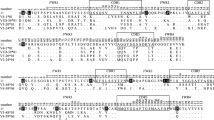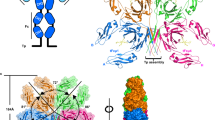Abstract
The Camelidae is the only taxonomic family known to possess functional heavy-chain antibodies, lacking light chains. We report here the 2.5 Å resolution crystal structure of a camel VH in complex with its antigen, lysozyme. Compared to human and mouse VH domains, there are no major backbone rearrangements in the VH framework. However, the architecture of the region of VH that interacts with a VL in a conventional Fv is different from any previously seen. Moreover, the CDR1 region, although in sequence homologous to human CDR1, deviates fundamentally from the canonical structure. Additionally, one half of the CDR3 contacts the VH region which in conventional immunoglobulins interacts with a VL, whereas the other half protrudes from the antigen binding site and penetrates deeply into the active site of lysozyme.
This is a preview of subscription content, access via your institution
Access options
Subscribe to this journal
Receive 12 print issues and online access
$189.00 per year
only $15.75 per issue
Buy this article
- Purchase on Springer Link
- Instant access to full article PDF
Prices may be subject to local taxes which are calculated during checkout
Similar content being viewed by others
References
Winter, G. & Milstein, C. Man-made antibodies. Nature 349, 293–299 (1991).
Nilsson, B. Antibody engineering. Curr. Opin. Struct. Biol. 5, 450–456 (1995).
Givol, D. The minimal antigen-binding fragment of antibodies-Fv fragment. Molec. Immunol. 28, 1379–1386 (1991).
Fan, Z. et al. Three-dimensional structure of an Fv from a human IgM immunoglobulin. J. Mol. Biol. 228, 188–207 (1992).
Padlan, E.A. Anatomy of the antibody molecule. Molec. Immunol. 31, 169–217 (1994).
Skerra, A. & Plückthun, A. Assembly of a functional immunoglobulin Fv fragment in E. coli. Science. 240, 1038–1041 (1988).
Skerra, A. Bacterial expression of immunoglobulin fragments. Curr. Opin. Immunol. 5, 256–262 (1993).
Glockshuber, R., Malia, M., Pfitzinger, I. & Plückthun, A. A comparison of strategies to stabilize immunoglobulin Fv fragments. Biochemistry. 29, 1362–1367 (1990).
Jung, S., Pastan, I. & Lee, B. Design of interchain disulfide bonds in the framework region of the Fv fragment of the monoclonal antibody B3. Proteins Struct. Funct. Genet. 19, 35–47 (1994).
Bird, R.E. et al. Single chain antigen binding proteins. Science. 241, 423–426 (1988).
Ward, E.S., Güssow, D., Griffiths, A.D., Jones, P.T. & Winter, G. Binding activities of a repertoire of single immunoglobulin variable domains secreted from E. coli. Nature 341, 544–546 (1989).
Hamers-Casterman, C. et al. Naturally occurring antibodies devoid of light chains. Nature 363, 446–448 (1993).
Muyldermans, S., Atarhouch, T., Saldanha, J., Barbosa, J.A. & Hamers, R. Sequence and structure of VH domain from naturally occurring camel heavy chain immunoglobulins lacking light chains. Prot. Engng. 7, 1129–1135 (1994).
Davies, J. & Riechmann, L. Camelising human antibody fragments: NMR studies on VH domains. FEBS Letters. 339, 285–290 (1994).
Chothia, C., Novotny, J., Bruccoleri, R. & Karplus, M. Domain association in immunoglobulin molecules. The packing of variable domains. J. Mol. Biol. 186, 651–663 (1985).
Stanfield, R.L., Takimoto-Kamimura, M., Rini, J.M., Profy, A.T. & Wilson, I.A. Major antigen-induced domain rearrangements in an antibody. Structure 1, 83–93 (1993).
Wu, T.T., Johnson, G. & Kabat, E.A. Length distribution of CDR H3 in antibodies. Proteins Struct. Funct. Genet. 16, 1–7 (1993).
Davies, J. & Riechmann, L. Antibody VH domains as small recognition units. Bio/Technology. 13, 475–479 (1995).
Sheriff, S. et al. Three-dimensional structure of an antibody-antigen complex. Proc. Natl. Acad. Sci. USA 84, 8075–8079 (1987).
Cohen, G.H., Sheriff, S. & Davies, D.R. Refined structure of the monoclonal antibody HyHEL-5 with its antigen hen egg-white lysozyme. Acta Crystallogr. D52, 315–326 (1996).
Padlan, E.A., Silverton, E.W., Sheriff, S., Cohen, G.H., Smith-Gill, S.J. & Davies, D.R. Structure of an antibody-antigen complex: Crystal structure of the HyHEL-10 Fab-lysozyme complex. Proc. Natl. Acad. Sci. USA 86, 5938–5942 (1989).
Amit, A.G., Mariuzza, R.A., Phillips, S.E. & Poljak, R.J. Three-dimensional structure of an antibody-antigen complex at 2.8 Å resolution. Science 233, 747–753 (1986).
Bhat, T.N. et al. Bound water molecules and conformational stabilization help mediate an antigen-antibody association. Proc. Natl. Acad. Sci. USA 91, 1089–1093 (1994).
Chitarra, V. et al. Three dimensional structure of a heteroclinic antigen-antibody cross-reaction complex. Proc. Natl. Acad. Sci. USA 90, 7711–7715 (1993).
Braden, B.C. et al. Three dimensional structures of the free and the antigen-complexed Fab form monoclonal anti-lysozyme antibody D44.1. J. Mol. Biol. 243, 767–781 (1994).
Padlan, E.A. et al. Structure of an antibody-antigen complex: Crystal structure of the HyHEL-10 Fab-lysozyme complex. Proc. Natl. Acad. Sci. USA. 86, 5938–5942 (1989).
Lescar, J. et al. Crystal structure of a cross-reaction complex between Fab F9.13.7 and guinea-fowl lysozyme. J. Biol. Chem. 270, 18067–18076 (1995).
Davies, D.R. & Padlan, E.A. Antibody-antigen complexes. Annu. Rev. Biochem. 59, 439–473 (1990).
Davies, D.R. & Cohen, G.H. Interactions of protein antigens with antibodies. Proc. Natl. Acad. Sci. USA 93, 7–12 (1996).
Hoogenboom, H.R. et al. Multi-subunit proteins on the surface of filamentous phage: methodologies for displaying antibody (Fab), heavy and light chains. Nucl. Adds Res. 19, 4133–4137 (1991).
Winter, G., Griffiths, A.D., Hawkins, R.E. & Hoogenboom, H.R. Making antibodies by phage display technology. Annu. Rev. Immunol. 12, 433–455 (1994).
Friguet, B., Chaffotte, A.F., Djavadi-Ohaniance, L.D. & Goldberg, M.E. Measurement of the true affinity constant in solution of antigen-antibody complexes by enzyme linked immunosorbent assay. J. Immunol. Meths. 77, 305–319 (1985).
Harata, K. X-ray structure of a monoclinic form of hen egg-white lysozyme crystallized at 313 K. Comparison of two independent molecules. Acta Crystallogr. D50, 250–257 (1994).
Kabat, E.A., Wu, T.T., Perry, H.M., Gottesman, K.S. & Foeler, C. Sequences of proteins of immunological interest. US Public Health Services, NIH, Bethesda, MD. Publication No. 91-3242 (1991).
Chothia, C., Boswell, D.R. & Lesk, A.M. The outline structure of the T-cell αβ receptor. EMBO J. 7, 3745–3755 (1988).
Kirkham, P.M., Mortari, F., Newton, J.A. & Schroeder, H.W., Jr. Immunoglobulin VH clan and family identity predicts variable domain structure and may influence antigen binding. EMBO J. 11, 603–609 (1992).
Chothia, C. et al. Structural repertoire of human VH segments. J. Mol. Biol. 227, 799–817 (1992).
Saul, F.A. & Poljak, R.J. Structural patterns at residue positions 9,18, 67, and 82 in the VH framework regions of human and murine immunoglobulins. J. Mol. Biol. 230, 15–20 (1993).
Riechmann, L. Rearrangement of the former VL interface in the solution structure of a camelised, single domain VH antibody. J. Mol. Biol. 259, 957–969 (1996).
Chothia, C. et al. Conformations of immunoglobulin hypervariable regions. Nature 342, 877–883 (1989).
Tramontane, A., Chothia, C. & Lesk, A.M. Framework residue 71 is a major determinant of the position and conformation of the second hypervariable region in the VH domains of immunoglobulins. J. Mol. Biol. 215, 175–182 (1990).
Barré, S., Greenberg, A.S., Flajnik, M.F. & Chothia, C. Structural conservation of hypervariable regions in immunoglobulins evolution. Nature Struct. Biology 1, 915–920 (1994).
Tomlinson, I.M., Walter, G., Marks, J.D., Llewelyn, M.B. & Winter, G. The repertoire of human germline VH sequences reveals about fifty groups of VH segments with different hypervariable loops. J. Mol. Biol. 227, 776–798 (1992).
Ghiara, J.B., Stura, E.A., Stanfield, L., Profy, A.T. & Wilson, I.A. Crystal structure of the principal neutralization site of HIV-1. Science 264, 82–85 (1994).
Webster, D.M., Henry, A.H. & Rees, A.R. Antibody-antigen interactions. Curr. Opin. Struct. Biol. 4, 123–129 (1994).
Fields, B.A., Goldbaum, F.A., Ysern, X., Poljak, R.J. & Marriuzza, R. Molecular basis of antigen mimicry by an anti-idiotope. Nature 374, 739–742 (1995).
Braden, B.C. & Poljak, R.J. Structural features of the reactions between antibodies and protein antigens. FASEB J. 9, 9–16 (1995).
All CCP4 software ‘The CCP4 Suite’: Programs for protein crystallography. Acta Crystallogr. D50, 760–763 (1994).
Lee, B. & Richards, F.M. The interpretation of protein structure: estimation of static accessiblility. J. Mol. Biol. 55, 379–400 (1971).
Kirby, A.J. Turning lysozyme upside down. Nature Struct. Biology 2, 923–925 (1995).
Novotny, J. Protein antigenicity: a thermodynarnic approach. Molec. Immunol. 28, 201–207 (1991).
Messerschmidt, A. & Plugrath, J.W. Crystal orientation and X ray pattern prediction routines for area-detector diffractometer systems in macromolecular crystallography. J. Appl. Crystallogr. 20, 306–315 (1987).
Brünger, A.T. X-PLOR Version 3.1 Manual: A system for X-ray crystallography and NMR. Yale University, New Haven, CT 06511, USA.(1992).
Jones, T.A., Zou, J.Y., Cowan, S.W. & Kjeldgaard, M. Improved method for building protein models in electron density maps and the location of errors in these models. Acta Crystallogr. A47, 110–119 (1991).
Brünger, A.T. The free R value: a novel statistical quantity for assessing the accuracy of crystal structures. Nature. 335, 472–475 (1992).
Laskowski, R.A., MacArthur, M.W., Moss, D.S. & Thornton, J.M. PROCHECK-A program to check the stereochemical quality of protein structures. J. Appl. Crystallogr. 26, 283–291 (1993).
Kraulis, P.J. MOLSCRIPT: a program to produce both detailed and schematic plots of protein structures. J. Appl. Crystallogr. 24, 946–950 (1991)
Merritt, E.A. & Murphy, M.E. RASTER 3D version 2.0 a program for photorealistic molecular graphics. Acta Crystallogr. D50, 869–873 (1994).
Author information
Authors and Affiliations
Rights and permissions
About this article
Cite this article
Desmyter, A., Transue, T., Ghahroudi, M. et al. Crystal structure of a camel single-domain VH antibody fragment in complex with lysozyme. Nat Struct Mol Biol 3, 803–811 (1996). https://doi.org/10.1038/nsb0996-803
Received:
Accepted:
Issue Date:
DOI: https://doi.org/10.1038/nsb0996-803
This article is cited by
-
Targeted drug delivery using nanobodies to deliver effective molecules to breast cancer cells: the most attractive application of nanobodies
Cancer Cell International (2024)
-
Evolution of immunogenetic components encoding ultralong CDR H3
Immunogenetics (2023)
-
Camels’ biological fluids contained nanobodies: promising avenue in cancer therapy
Cancer Cell International (2022)
-
Structural insights into the non-inhibitory mechanism of the anti-EGFR EgB4 nanobody
BMC Molecular and Cell Biology (2022)
-
Therapeutische Nanobodies gegen SARS-CoV-2
BIOspektrum (2022)



